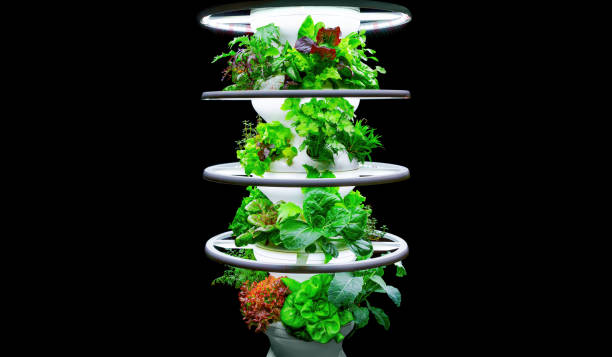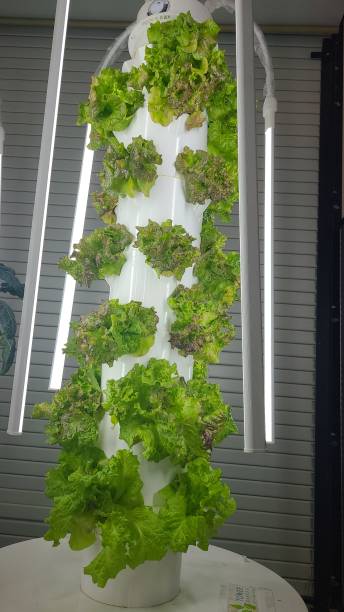Embarking on a journey to cultivate fresh, nutrient-rich produce in limited spaces has never been more accessible, thanks to the innovative realm of hydroponic towers. A vertical garden powered by hydroponic systems transforms balconies, small patios, and even indoor nooks into verdant havens brimming with crisp leafy greens, aromatic herbs, and vibrant fruits. By leveraging hydroponic towers, enthusiasts can experience 3x faster growth compared to traditional soil-based methods, all while conserving up to 95% of water. In this comprehensive guide, we will delve deep into everything you need to know to design, set up, and maintain a thriving hydroponic tower garden—a truly revolutionary way to practice sustainable urban farming.
What Are Hydroponic Towers and How Do They Revolutionize Vertical Gardening?
Hydroponic towers represent a cutting-edge approach to soilless cultivation, consisting of a tall, cylindrical structure equipped with multiple net pots that cradle individual plants. Instead of relying on earth, these systems circulate nutrient-rich water to feed roots directly. By growing plants in a stacked, vertical arrangement, a single hydroponic tower garden can yield up to 30% more produce per square foot than horizontal beds, making it an ideal solution for small-space dwellers. This innovative setup not only maximizes productivity but also eliminates the need for heavy soil and cumbersome traditional planters.
Key Components and Features of Hydroponic Towers
- Reservoir and Water Pump: At the base of each hydroponic tower lies a reservoir that holds the nutrient solution. A submersible pump continuously circulates this mixture upward, ensuring all plants receive an even distribution of water and essential minerals.
- Net Pots and Growth Media: Each planting site along the tower features a net pot, often filled with a sterile growing media such as rockwool or coconut coir. This substrate anchors the plant roots while allowing optimal oxygen exchange.
- Vertical Stacking Design: The signature vertical layout accommodates dozens of plants in a footprint as small as one square meter. By stacking net pots in tiers, the hydroponic tower leverages gravity to facilitate nutrient recirculation.
- Optional LED Lighting (for Indoor Use): For those establishing an indoor vertical garden, adjustable LED grow lights provide the full spectrum of light required for photosynthesis. These lights often feature timers, automating the photoperiod and enabling consistent growth cycles.
- Durable, Food-Grade Materials: Modern hydroponic towers are constructed from 2mm-thick, UV-resistant plastics that withstand both indoor and outdoor conditions without fading or leaching harmful chemicals.
Benefits of Cultivating a Vertical Garden with Hydroponic Towers
Transitioning to a hydroponic tower garden unlocks a multitude of advantages that cater to both beginner gardeners and seasoned horticulturists. Below, we explore the essential benefits that make hydroponic towers one of the most sought-after solutions for vertical gardening enthusiasts.
Space Efficiency: Maximizing Yield in Minimal Footprint
One of the most compelling reasons to adopt hydroponic towers is the remarkable space savings they deliver. Traditional gardens often require extensive horizontal space, whereas a vertical garden can flourish in as little as 1 square meter. Urban dwellers with balconies, patios, or limited backyard space can now cultivate up to 24 plants in a single tower. By stacking plants in a vertical arrangement, hydroponic towers drastically increase yield per square foot, allowing gardeners to grow more varieties of leafy greens, herbs, and even vine crops within the same footprint.
Accelerated Growth and Increased Yields
Hydroponic tower gardens circumvent many challenges associated with soil cultivation, resulting in accelerated plant growth and healthier yields. Because roots are directly suspended in a nutrient solution that contains precisely balanced macro- and micronutrients, plants can absorb what they need more efficiently. Studies have shown that hydroponic towers can facilitate growth rates up to three times faster than soil-based methods. Moreover, the streamlined nutrient delivery system offers a 30% increase in overall yield, enabling gardeners to harvest multiple crop cycles throughout the year.
Water Conservation and Sustainability
Water scarcity is a growing concern worldwide, and hydroponic towers address this issue by reducing water usage by up to 95% compared to conventional farming techniques. In a recirculating hydroponic system, excess nutrient solution that infiltrates the root zone collects at the bottom reservoir, where it is pumped back up for reuse. This closed-loop design dramatically reduces water waste, making hydroponic tower gardens an eco-friendly and sustainable choice for conscientious growers.
Reduced Pest and Disease Pressure
Without soil, many soil-borne pests and pathogens are effectively eliminated, significantly reducing the need for chemical pesticides and fungicides. The controlled environment of a vertical garden also makes it easier to monitor plant health, detect early signs of nutrient deficiencies, and intervene before widespread issues occur. The result is cleaner, healthier produce that can often be consumed with minimal washing, as dust and soil residue are virtually absent.
Designing Your Own Hydroponic Tower Garden: Step-by-Step Guide
Creating a flourishing hydroponic tower garden at home requires careful planning and attention to detail. Below are the essential steps to ensure your vertical garden thrives from seedling to harvest.
Choosing the Right Location for Your Vertical Garden
- Indoor vs. Outdoor Considerations: Decide whether you’ll keep your hydroponic towers indoors or outdoors. Outdoor setups benefit from natural sunlight—which may allow you to forgo artificial lighting—while indoor towers require well-placed LED grow lights to ensure adequate light intensity and duration.
- Proximity to Power and Water Sources: Ensure the chosen site is near an electrical outlet to power pumps and lights (if used) and has easy access to water for reservoir refills.
- Temperature and Humidity Control: Most leafy greens and herbs prefer temperatures between 65°F and 75°F (18°C–24°C). If placing your system outdoors, consider seasonal temperature fluctuations and the potential need to move the tower indoors during extreme weather.
Selecting Suitable Plants for Your Hydroponic Tower Garden
- Leafy Greens and Lettuce Varieties: Fast-growing, shallow-rooted greens such as lettuce, arugula, and spinach are ideal candidates for hydroponic towers. These crops establish quickly and can be harvested continuously.
- Herbs and Culinary Staples: Basil, parsley, chives, and cilantro flourish in vertical gardens. Their compact growth habits and relatively low nutrient demands make them perfect for hydroponic cultivation.
- Fruit Crops and Vine Plants: With appropriate support, vine crops like cherry tomatoes, cucumbers, and certain pepper varieties can be trained to climb the tower structure. Outdoor setups are particularly beneficial for pollination by bees and wind, ensuring robust fruit production.
Setting Up the Nutrient Delivery and Lighting System
- Assembling the Tower: Follow manufacturer instructions to stack tower sections securely. Ensure each section is level to avoid uneven nutrient flow.
- Filling the Reservoir: Combine water with a balanced hydroponic nutrient solution, adjusting the concentration according to the crop type. Use a quality EC (electrical conductivity) meter to verify nutrient strength.
- Installing the Pump and Tubing: Position the submersible water pump at the bottom of the reservoir. Connect tubing to the top irrigation inlet and confirm the flow rate distributes water evenly to all net pots.
- Positioning LED Grow Lights (Indoor): Install adjustable LED fixtures above the tower, ensuring coverage of all tiers. Set the photoperiod (typically 14–16 hours per day for leafy greens) using built-in timers to mimic daylight cycles.
Maintenance Tips for a Thriving Hydroponic Tower Garden
Achieving consistent yields from your hydroponic tower requires regular monitoring and proactive care. The following practices will help you maintain optimal growing conditions and troubleshoot potential issues.
Monitoring pH and Nutrient Levels
- pH Range: Aim for a pH between 5.5 and 6.5, which is ideal for nutrient uptake in most hydroponically grown vegetables and herbs. Use a reliable pH meter or testing kit at least twice a week, adjusting with pH up or down solutions as needed.
- Nutrient Concentration: Check EC (electrical conductivity) daily to ensure the nutrient concentration remains within the recommended range (typically 1.2–2.0 mS/cm, depending on crop stage). Replenish or adjust nutrient solution promptly when levels drop.

Pruning, Training, and Harvesting Strategies
- Pruning for Airflow: Trim lower leaves and crowded growth to encourage airflow around stems, reducing fungal and pest pressures. Remove any yellowing or diseased foliage immediately.
- Training Vine Crops: For tomatoes, cucumbers, and other vining plants, use soft ties or clips to secure stems to built-in trellises or stakes. This training prevents vines from blocking light to lower tiers.
- Continuous Harvesting: Harvest leafy greens by cutting outer leaves first, allowing the inner rosette to continue producing. This “cut-and-come-again” approach maximizes yield without uprooting plants prematurely.
Troubleshooting Common Issues
- Algae Growth: Algae can proliferate in reservoirs exposed to light. Mitigate this by covering the reservoir and opaque tubing, or by adding an algae-inhibiting agent specifically formulated for hydroponics.
- Root Rot and Oxygen Deficiency: Ensure roots remain well-oxygenated. If roots appear brown and slimy, increase aeration by adding an air stone to the reservoir or decreasing reservoir depth.
- Pest Infestations: Although less common in soilless systems, aphids, spider mites, and whiteflies can still appear—especially outdoors. Utilize integrated pest management (IPM) techniques, such as introducing beneficial insects (e.g., ladybugs) or applying organic horticultural oils to affected foliage.
Maximizing Success: Tips for First-Time Vertical Gardeners
- Start Small and Expand Gradually: If you are new to hydroponics, consider starting with a single tower and a handful of plants. As you gain confidence and experience, add more towers to increase production.
- Keep Detailed Logbooks: Record pH, nutrient levels, environmental conditions, planting dates, and yields. Over time, you’ll identify trends and fine-tune your system for peak performance.
- Leverage Technology and Communities: Join online forums, local gardening clubs, and social media groups dedicated to hydroponics. Sharing experiences and troubleshooting challenges with fellow growers can accelerate your learning curve.
- Experiment with Crop Rotations: Rotate different crops seasonally—e.g., switch from lettuce and herbs in spring to leafy greens like kale and Swiss chard in cooler months—to maintain nutrient balance and reduce disease risk.
- Invest in Quality Growing Media: Although the initial cost may be higher, premium rockwool or coco coir ensures better root support and moisture retention, translating to healthier plants and higher yields.
Conclusion: Elevate Your Urban Farming Journey with ALTO Garden
Embracing a hydroponic tower garden offers a transformative way to cultivate fresh, nutritious produce while conserving space, water, and time. Whether you are a seasoned horticulturist or a complete beginner, a vertical garden powered by hydroponic towers delivers unparalleled efficiency, year-round harvests, and minimal environmental impact. With an initial investment in quality components and ongoing attention to pH, nutrient balance, and pruning techniques, you can enjoy a continuous supply of leafy greens, fragrant herbs, and even vine fruits—right from the comfort of your home. Ready to revolutionize your home gardening journey? Discover how ALTO Garden can help you grow organic, flavorful produce faster and more sustainably than ever before.

